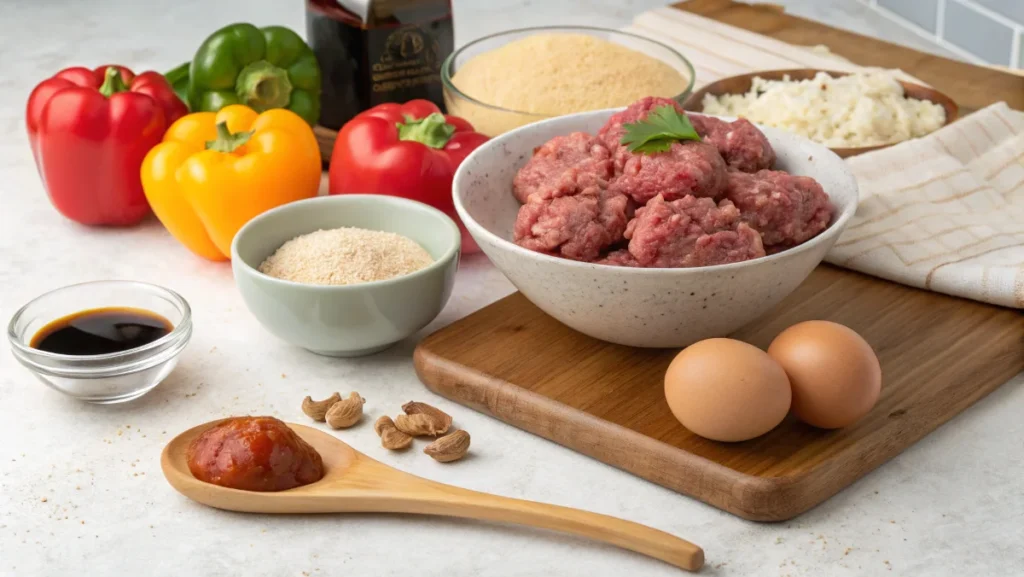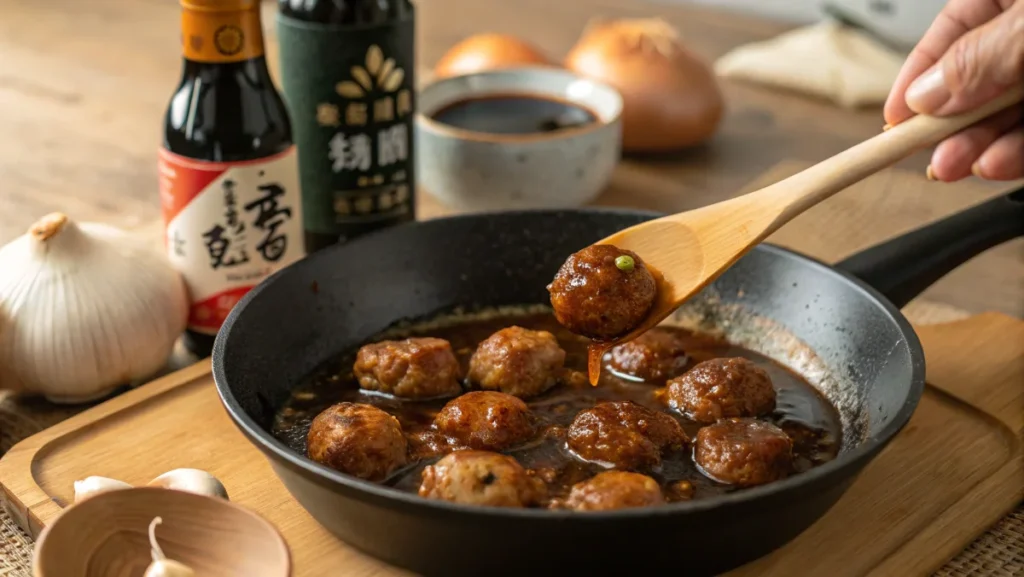Sweet and sour meatballs have become a beloved dish across various cultures and are a staple on both casual and festive dining tables. The perfect balance of tangy, sweet, and savory flavors has made this dish a favorite for many. Whether served as a party appetizer or a main dish, this recipe is truly versatile.
One of the keys to creating perfectly cooked meatballs lies in mastering cooking times, much like other dishes. For instance, understanding the timing of shrimp preparation can enhance your culinary skills. If you’re curious, learn more about How Long Does It Take to Cook Raw Shrimp? Perfect Timing Explained.

The History of Sweet and Sour Meatballs
The origins of sweet and sour meatballs are quite fascinating, as this dish has evolved over time and across various regions. Many believe that sweet and sour combinations have existed for centuries in both Asian and European cuisines, with various cultures incorporating these bold flavors into their cooking.
- Asian Influence: In Chinese cuisine, sweet and sour flavors are an integral part of the culinary tradition. The iconic sweet and sour beef dish, for example, dates back to the Qing Dynasty, and it’s possible that the idea of this dish grew from that. Over time, these recipes spread to other regions and adapted to local tastes.
- Western Adaptations: In the United States, the dish evolved as people from various backgrounds began incorporating different types of meats, such as beef and turkey, into the recipe. Additionally, Western-style sweet and sour sauces, made with ingredients like ketchup, vinegar, and sugar, became a defining feature.
Despite the cultural differences in preparation, one thing is clear: people have loved sweet and sour meatballs for generations, and they continue to be a favorite today.
What Makes Sweet and Sour Meatballs Unique?
What sets sweet and sour meatballs apart from other meatball recipes is the harmonious balance of flavors, which makes each bite a delightful experience. Additionally, the unique aspect of this dish lies in its ability to combine the savory richness of the meat with the tanginess of vinegar and the sweetness of sugar or fruit. Furthermore, the contrasting flavors complement each other perfectly, resulting in a satisfying and unforgettable meal. As a result, the sweet and sour meatballs offer a perfect balance that other meatball dishes may lack. The following factors contribute to the distinctiveness of sweet and sour meatballs:
- Flavor Profile: The sauce is the hero. A tangy and sweet glaze coats the meat, which helps the dish stand out from typical savory recipes. People often make the sauce using ingredients like vinegar, ketchup, soy sauce, or pineapple juice, making it versatile and adjustable to taste preferences.
- Texture Contrast: The meatballs themselves are often tender and juicy on the inside, thanks to the careful selection of ingredients and cooking method. The tangy-sweet sauce, when poured over the meat, creates an exciting contrast of textures.
- Versatility: You can make meatballs with different types of meat, including beef, chicken, and even turkey. This flexibility allows home cooks to adjust the recipe based on dietary preferences or availability. By switching up the protein, the dish can be customized to suit various tastes while maintaining its delicious balance of flavors.
Ultimately, the combination of tangy and sweet flavors, paired with tender meatballs, is what makes this dish stand out. In addition, the balance of textures and flavors creates a satisfying dish that appeals to a wide range of tastes. As a result, this dish becomes a favorite in many households, offering both richness and freshness in every bite.
Key Ingredients for Sweet and Sour Meatballs
To create a dish that truly stands out, selecting the right ingredients is essential. In fact, the quality of your ingredients will directly impact the flavor of the dish. For example, fresh herbs and high-quality meat will elevate the overall taste. Now, here’s a breakdown of the key ingredients you’ll need to make a delicious version of this recipe:
- Ground Meat:
- Traditionally, sweet and sour meatballs are made with ground beef. However, you can use other meats such as turkey or chicken if preferred.
- Meatball consistency can be enhanced by adding breadcrumbs or eggs, which help bind the meat together.
- Sweet and Sour Sauce:
- The sauce is the star of the show! A typical sweet and sour sauce is a blend of vinegar, sugar, ketchup, soy sauce, and sometimes pineapple juice.
- You can also incorporate fresh fruit like pineapple chunks or bell peppers to enhance both flavor and texture.
- Seasonings:
- Garlic, ginger, soy sauce, and pepper are commonly used to season the meatballs.
- A pinch of salt and a dash of black pepper elevate the overall taste.
- Vegetables:
- While not always essential, vegetables like bell peppers, onions, and pineapple chunks can be added to the sauce to provide extra color and flavor.
- Breadcrumbs and Eggs:
- These are essential for binding the meat mixture and ensuring the meatballs hold their shape during cooking.

Step-by-Step Recipe for Sweet and Sour Meatballs
Making sweet and sour meatballs at home is straightforward. To begin, follow these simple steps to create your own batch of delicious meatballs. Additionally, you’ll infuse them with the perfect balance of sweet and tangy flavors, ensuring a mouthwatering dish every time. In the end, you’ll be able to enjoy homemade meatballs that are both easy to make and full of flavor.
Ingredients:
- 1 pound ground beef or turkey
- 1/2 cup breadcrumbs
- 1 egg
- 1 tablespoon soy sauce
- 1 teaspoon garlic powder
- 1 teaspoon onion powder
- Salt and pepper to taste
- 2 tablespoons olive oil (for frying)
For the Sauce:
- 1/2 cup ketchup
- 1/4 cup vinegar (white or apple cider)
- 1/4 cup sugar
- 1/4 cup pineapple juice (optional for extra sweetness)
- 2 tablespoons soy sauce
- 1 tablespoon cornstarch (to thicken the sauce)
- 1/2 cup bell pepper, chopped
- 1/2 cup pineapple chunks (optional)
Directions:
- Preheat the Oven: Preheat your oven to 350°F (175°C).
- Prepare the Meatballs:
- In a mixing bowl, combine the ground meat, breadcrumbs, egg, soy sauce, garlic powder, onion powder, salt, and pepper. Mix well until everything is evenly distributed.
- Roll the meat mixture into small meatballs, about 1-1.5 inches in diameter.
- Cook the Meatballs:
- Heat olive oil in a large pan over medium heat. Once the oil is hot, add the meatballs in batches and cook until browned on all sides (about 5-6 minutes per batch).
- Once cooked, transfer the meatballs to a baking dish.
- Prepare the Sauce:
- In a saucepan, whisk together the ketchup, vinegar, sugar, pineapple juice, soy sauce, and cornstarch.
- Bring to a simmer over medium heat and stir constantly until the sauce thickens (about 5-7 minutes).
- Add chopped bell peppers and pineapple chunks to the sauce, and simmer for another 2-3 minutes.
- Combine Meatballs and Sauce:
- Pour the tangy-sweet sauce over the meat in the baking dish. Ensure the meat is well-coated.
- Bake in the preheated oven for 15-20 minutes, or until the meatballs are fully cooked through and the sauce is bubbly.
- Serve:
- Once done, serve the sweet and sour meatballs hot, garnished with chopped cilantro or green onions if desired.

Tips for Choosing the Best Meat for Meatballs
Choosing the right meat for your dish is essential for achieving the perfect texture and flavor. Here are some tips to help you make the best selection:
- Lean Meat vs. Fatty Meat: For juicy and flavorful meatballs, opt for meat with a moderate fat content. A 70-30 blend of lean to fatty meat (such as beef) ensures that your meatballs remain moist and tender.
- Ground Beef: Beef is traditionally used in sweet and sour meatballs because of its rich flavor and tender texture. It pairs beautifully with the tangy sauce, absorbing the flavors and creating a satisfying bite.
- Turkey or Chicken: For a leaner option, turkey or chicken are good substitutes. However, you may need to add extra seasoning or binders, like breadcrumbs, to prevent the meatballs from being too dry.
By considering the fat content and flavor profile of the meat you choose, you can create a more personalized version of sweet and sour meatballs.
Variations of Sweet and Sour Meatballs Around the World
The basic idea of sweet and sour meatballs stays the same, but different cultures have added their own twist with local ingredients and cooking styles. Here are some popular versions:
- Swedish Sweet and Sour Meatballs: Swedish meatballs, or “Köttbullar,” are usually served with a creamy gravy, but many variations incorporate a sweet and sour sauce made with lingonberries, which adds a fruity sweetness.
- Asian-Inspired Meatballs: In many Chinese-American households, sweet and sour meatballs are made with a more pronounced pineapple flavor. The addition of ingredients like bell peppers, onions, and ginger gives the dish an Asian flair.
- Caribbean Sweet and Sour Meatballs: In the Caribbean, sweet and sour meatballs are often prepared with tropical fruits such as mango, pineapple, and papaya. The sauce is typically a mix of vinegar, brown sugar, and rum, adding depth and a hint of sweetness.
- Italian Sweet and Sour Meatballs: Some Italian-American versions of sweet and sour meatballs use balsamic vinegar and sugar to create a rich, tangy glaze. These meatballs may also feature Italian herbs like basil and oregano.
Each variation provides a unique twist on the classic sweet and sour meatballs, highlighting the creativity of different culinary traditions.
Pairing Sweet and Sour Meatballs with Side Dishes
Sweet and sour meatballs are versatile and can be paired with a variety of side dishes that complement their bold flavors. Here are a few excellent options:
- Rice: A classic pairing with sweet and sour meatballs is plain steamed rice or fried rice. The rice helps balance out the tanginess of the sauce and absorbs all the delicious flavors.
- Vegetable Stir-Fry: A quick stir-fry with vegetables such as broccoli, bell peppers, and carrots offers a fresh, crunchy contrast to the tender meatballs.
- Mashed Potatoes: If you’re looking for something comforting, mashed potatoes can be a great side dish. Their creamy texture complements the sweet and sour sauce well.
- Green Salad: A light, crisp salad with a vinaigrette dressing can offer a refreshing contrast to the richness of the meatballs.
Feel free to mix and match based on your preferences and occasion!
Nutritional Information of Sweet and Sour Meatballs
Understanding the nutritional information of sweet and sour meatballs is important for those who are mindful of their dietary intake. While the dish offers a balanced combination of protein, carbohydrates, and fats, it can also be high in sugar and sodium, depending on how it’s prepared. Here’s an approximate breakdown:
- Calories: 1 serving (4 meatballs) contains roughly 250-300 calories.
- Protein: Sweet and sour meatballs are an excellent source of protein, with around 15-20 grams per serving, depending on the meat used.
- Carbohydrates: The sweet and sour sauce may contribute 15-25 grams of carbs per serving, mostly from sugars and starches.
- Fat: With fattier cuts of meat, each serving can contain 15-20 grams of fat, but leaner meat options like turkey will lower the fat content.
If you’re looking to reduce the sugar or calorie count, consider making your own sweet and sour sauce with healthier alternatives. Alternatively, you can use leaner meats to cut down on fat. In addition, experimenting with different ingredients will help you create a dish that suits your health goals without compromising on flavor.
How to Store and Reheat Sweet and Sour Meatballs
To ensure your sweet and sour meatballs stay fresh for longer, it’s important to store and reheat them correctly. First, make sure to store them in an airtight container to maintain their flavor and texture. Additionally, when reheating, be sure to heat them thoroughly to avoid any uneven cooking. As a result, your meatballs will taste just as delicious the second time around.
Storing:
- In the Fridge: After cooking, let the meatballs cool to room temperature. Then, place them in an airtight container and store them in the refrigerator for up to 3-4 days.
- In the Freezer: For longer storage, freeze the meatballs in a single layer on a baking sheet. Once frozen solid, transfer them to a freezer bag and store them for up to 3 months.
Reheating:
- In the Oven: Preheat your oven to 350°F (175°C). Place the meatballs in a baking dish and cover them with foil to prevent them from drying out. Reheat for about 20 minutes or until hot.
- On the Stovetop: Place the meatballs in a skillet over medium heat. Add a little extra sauce or water to prevent burning, and stir occasionally until heated through.
- Microwave: For a quick reheating method, use the microwave on high for 1-2 minutes, stirring halfway through.
Sweet and Sour Meatballs for Special Occasions
Sweet and sour meatballs are a fantastic dish to serve during special occasions such as family gatherings, parties, or holiday dinners. Here are a few ideas for making the dish stand out:
- For Parties: Serve the meatballs on a platter with toothpicks for easy serving as appetizers. You can also serve them with a side of dipping sauce.
- For Holidays: During festive seasons like Thanksgiving or Christmas, sweet and sour meatballs can be a great addition to a buffet-style meal, offering a balance of flavors alongside traditional dishes.
- For Birthdays: Customize the meatballs with creative garnishes or serve them in small portions for children’s parties.
The versatility and flavor of sweet and sour meatballs make them perfect for a wide variety of occasions.
FAQs:
1. What Are Sweet and Sour Meatballs?
This dish combines flavorful meatballs with a tangy, sweet sauce. The meatballs are typically made from ground beef, turkey, or chicken and are cooked until browned and tender. The sauce, made from ingredients like vinegar, sugar, ketchup, soy sauce, and sometimes fruit (like pineapple), provides a perfect balance of sweet and sour flavors. This versatile dish is often served as a main course, appetizer, or party dish.
2. How Long Do You Cook Sweet and Sour Meatballs in the Oven?
When baking sweet and sour meatballs in the oven, the cooking time usually ranges from 15 to 20 minutes at 350°F (175°C). The meatballs should be fully cooked through, with an internal temperature of 160°F (71°C) if using beef. For extra flavor, you can bake them in a sweet and sour sauce for the last 10 minutes to let the sauce caramelize and coat the meatballs evenly.
3. How Do You Make Sweet and Sour Meatballs from Scratch?
Making sweet and sour meatballs from scratch involves two main steps: preparing the meatballs and making the sauce. Here’s a simple breakdown:
- Meatballs: Combine ground meat (like beef or turkey), breadcrumbs, egg, soy sauce, garlic powder, and seasoning. Shape into small balls and brown them in a pan or bake them in the oven.
- Sauce: In a separate saucepan, mix vinegar, sugar, ketchup, soy sauce, and cornstarch (for thickening). Bring the mixture to a simmer, stirring frequently until it thickens. Pour the sauce over the cooked meatballs and bake together to meld the flavors.
4. Can I Make Sweet and Sour Meatballs Ahead of Time?
Yes, you can definitely make sweet and sour meatballs ahead of time! You can prepare the meatballs and sauce in advance, then store them separately in the refrigerator for up to 2-3 days. When you’re ready to serve, simply reheat the meatballs and sauce together in the oven or stovetop. Alternatively, you can freeze the cooked meatballs (without sauce) for up to 3 months, and reheat them with fresh sauce when needed.
Conclusion
Sweet and sour meatballs are a timeless dish that offers a delightful balance of flavors. Whether you’re preparing them for a casual dinner, a festive gathering, or simply a weeknight meal, this versatile recipe never fails to impress. By experimenting with different meats, sauces, and cooking techniques, you can adapt the dish to suit your unique tastes. If you’re interested in mastering cooking times for other dishes, such as shrimp, check out How Long to Bake Shrimp at 400 Degrees Fahrenheit – Best Tips for Cooking to enhance your culinary skills further.

